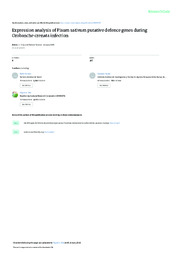Expression analysis of Pisum sativum putative defence genes during Orobanche crenata infection.
Expression analysis of Pisum sativum putative defence genes during Orobanche crenata infection.
Author(s): DIE, J. V.; ROMAN, B.; SALVADOR, N.; RODRIGUEZ, M. A. D.; GONZÁLEZ-VERDEJO, C. I.
Summary: The root holoparasitic angiosperm Orobanche crenata is a severe constraint to the cultivation of legumes. Breeding for resistance is a difficult task. Understanding the mechanisms underlying host resistance is a fundamental issue for the genetic improvement of legumes. In this work, the temporal expression patterns of 8 defence-genes known to be involved in different metabolic pathways activated during several plant-pathogen interactions were investigated in Pisum sativum. Molecular analyses were carried out using quantitative real-time polymerase chain reaction during the initial stages of the parasitisation process in susceptible (Messire) and incompletely resistant (Ps624) pea genotypes. Transcriptional changes in response to O. crenata revealed induction of genes putatively encoding pathogenesis-related proteins, peroxidase activity, and dehydration stress-responsive signalling. This, combined with high constitutive gene expression mediating the phenylpropanoid pathway were observed as part of the defence mechanisms triggered in Ps624 to restrict the growth of the parasite.
Publication year: 2009
Types of publication: Journal article
Unit: Embrapa Cassava & Fruits
Observation
Some of Embrapa's publications are published as ePub files. To read them, use or download one of the following free software options to your computer or mobile device. Android: Google Play Books; IOS: iBooks; Windows and Linux: Calibre.
Access other publications
Access the Agricultural Research Database (BDPA) to consult Embrapa's full library collection and records.
Visit Embrapa Bookstore to purchase books and other publications sold by Embrapa.

